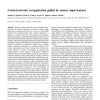Free Online Productivity Tools
i2Speak
i2Symbol
i2OCR
iTex2Img
iWeb2Print
iWeb2Shot
i2Type
iPdf2Split
iPdf2Merge
i2Bopomofo
i2Arabic
i2Style
i2Image
i2PDF
iLatex2Rtf
Sci2ools
BC
2002
2002
Cortical network reorganization guided by sensory input features
Abstract. Sensory experience alters the functional organization of cortical networks. Previous studies using behavioral training motivated by aversive or rewarding stimuli have demonstrated that cortical plasticity is specific to salient inputs in the sensory environment. Sensory experience associated with electrical activation of the basal forebrain (BasF) generates similar input specific plasticity. By directly engaging plasticity mechanisms and avoiding extensive behavioral training, BasF stimulation makes it possible to efficiently explore how specific sensory features contribute to cortical plasticity. This review summarizes our observations that cortical networks employ a variety of strategies to improve the representation of the sensory environment. Different combinations of receptive-field, temporal, and spectrotemporal plasticity were generated in primary auditory cortex neurons depending on the pitch, modulation rate, and order of sounds paired with BasF stimulation. Simple t...
| Added | 16 Dec 2010 |
| Updated | 16 Dec 2010 |
| Type | Journal |
| Year | 2002 |
| Where | BC |
| Authors | Michael P. Kilgard, Pritesh K. Pandya, Navzer D. Engineer, Raluca Moucha |
Comments (0)

